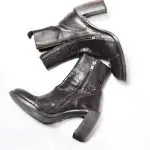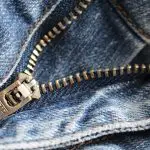To make a padded fabric camera case from scratch, start by choosing a durable, tightly woven fabric like nylon and shock-absorbing padding such as foam or neoprene. Measure your camera and accessories precisely to create an accurate pattern with added padding space. Cut fabric and padding carefully, then sew them together securely, adding a closure like velcro or a zipper. Don’t forget to sew interior compartments to organize gear safely. Keep going to uncover tips for perfect assembly and finishing touches.
Table of Contents
Key Takeaways
- Select durable, tightly woven fabric and shock-absorbing padding like foam or neoprene for effective camera protection.
- Accurately measure camera dimensions and add padding allowance to create a snug, custom-fit pattern.
- Cut fabric and padding precisely, pin layers securely, and prepare fabric by washing and ironing to prevent shrinkage.
- Sew padding to fabric evenly, assemble the main body with right sides together, and turn right side out for a clean finish.
- Add a closure (velcro, snaps, or zipper) and sew padded interior compartments to organize and protect accessories.
Choosing the Right Fabric for Your Camera Case
Selecting the right fabric is essential when making your padded camera case because it directly affects durability and protection. You want a material that resists wear, water, and abrasion to keep your gear safe.
Look for tightly woven fabrics like nylon or polyester; they’re strong, lightweight, and water-resistant. Canvas is also a solid choice if you prefer a sturdier, natural feel, but make sure it’s treated for water resistance.
Avoid flimsy or stretchy fabrics since they won’t hold up under daily use or protect your camera properly. Also, consider the fabric’s thickness—too thin won’t offer protection, too thick may add unnecessary bulk.
Selecting the Best Padding Material
Although the fabric provides the outer shell, padding plays an essential role in absorbing shocks and protecting your camera from impacts.
You’ll want to pick a material that’s thick enough to cushion but not so bulky that it becomes cumbersome. Consider these common options:
- Foam sheets: Lightweight and shock-absorbent, easy to cut and shape.
- Fleece: Soft, adds moderate padding, and prevents scratches.
- Quilt batting: Offers a fluffy, cushioned layer but may compress over time.
- Neoprene: Durable, water-resistant, and provides excellent shock absorption.
Think about your camera’s fragility and how much protection you need.
Also, balance padding thickness with portability. Choosing the right padding sets the foundation for a reliable, protective case that suits your everyday use.
Measuring Your Camera and Accessories
Before you start cutting fabric, make certain you measure your camera with precision to guarantee a snug fit.
Don’t forget to include extra space for any accessories you plan to carry, like batteries or lenses.
Accurate measurements will help you create a case that’s both protective and practical.
Camera Dimensions Accuracy
When you measure your camera and accessories accurately, you guarantee the padded fabric case fits perfectly and offers the best protection. Start by using a reliable measuring tool like a digital caliper or a flexible tape measure. Measure the widest, tallest, and deepest parts of your camera, including any protruding buttons or grips.
Don’t forget to note the dimensions of essential accessories you plan to carry. Record your measurements carefully to avoid mistakes when cutting fabric and padding.
- Measure the body width, height, and depth precisely
- Include lens dimensions if attached or stored separately
- Check for any irregular shapes or protrusions
- Double-check your numbers before proceeding with pattern making
Accurate measurements prevent a loose or overly tight case, ensuring your gear stays safe.
Accessory Space Considerations
Now that you’ve gathered precise measurements of your camera, it’s important to account for the space your accessories will need inside the case.
Start by listing all items you plan to carry—batteries, memory cards, lens caps, chargers, and cables. Measure each accessory’s dimensions carefully, including any bulky parts or packaging. Add a little extra room around each item for easy removal and to prevent damage.
When sketching your case layout, position accessories thoughtfully to avoid crushing or scratching your camera. Keep in mind that padding will add thickness, so factor that into your final dimensions.
Creating a Pattern for Your Case
Since every camera has unique dimensions, you’ll need to create a custom pattern that fits yours perfectly. Start by measuring your camera’s height, width, and depth with a tape measure. Add about half an inch to each measurement to allow for padding and seam allowances.
Next, sketch a simple box shape on paper representing the main body of your case. Don’t forget to include a flap or closure area if you want one.
Here’s what to focus on when creating your pattern:
- Measure your camera accurately from all sides.
- Include extra space for padding and sewing.
- Draw a separate piece for the flap or lid.
- Mark seam allowances clearly on your pattern.
This guarantees a snug fit and smooth assembly in the next steps.
Cutting Fabric and Padding Pieces
You’ll want to pick fabric and padding that offer both durability and protection for your camera.
Measure your pattern pieces carefully to guarantee each cut fits perfectly.
Use sharp scissors or a rotary cutter for clean, precise edges.
Choosing Fabric and Padding
Although selecting the right fabric and padding may seem straightforward, choosing materials that balance durability and softness is key to protecting your camera.
You want fabric that resists wear and tear but feels gentle enough to prevent scratches. For padding, opt for something thick enough to absorb shocks but flexible enough to keep your case lightweight and portable.
Consider these tips when choosing your materials:
- Use tightly woven fabrics like canvas or denim for durability.
- Select soft inner linings such as fleece or microfiber to protect your camera’s finish.
- Choose foam padding with a density that cushions without adding bulk.
- Avoid materials that absorb moisture, as they can damage your gear over time.
Picking the right combo guarantees your camera stays safe and your case lasts.
Measuring and Cutting Techniques
Before cutting any fabric or padding, carefully measure your camera and plan each piece to guarantee a snug fit. Use a flexible measuring tape to note the camera’s length, width, and height, adding about half an inch to each dimension for seam allowances.
Sketch the shapes you’ll need on paper first. Lay your fabric flat on a clean surface, then place your padding on top. Pin the patterns to both layers to keep them aligned while cutting.
Use sharp fabric scissors or a rotary cutter for clean, precise edges. Cut slowly and follow your measurements exactly to make certain all pieces match up perfectly during assembly. Taking time here prevents issues later, making sure your camera case protects your gear comfortably and securely.
Preparing the Fabric for Sewing
Since accurate cutting and alignment are essential, you should start by washing and ironing your fabric to remove any wrinkles or shrinkage. This guarantees your pieces lay flat and match your measurements perfectly.
Next, double-check the grainline on each fabric piece to maintain structure and durability. Pin your fabric layers together precisely, avoiding any shifting during sewing.
Finally, mark seam allowances clearly with tailor’s chalk or fabric markers to guide your stitching.
Here’s a quick checklist:
- Wash and iron fabric to prevent distortion
- Align fabric grainlines carefully
- Pin layers securely to avoid movement
- Mark seam allowances for accurate stitching
Following these steps will help you achieve a professional, clean finish on your camera case.
Sewing the Padding to the Fabric
You’ll want to pick padding that’s both protective and easy to sew through, like foam or quilt batting.
Make sure to attach it firmly to your fabric so it won’t shift during construction. Using pins or a temporary adhesive can help keep everything in place as you sew.
Choosing Padding Materials
Although selecting the right padding material might seem straightforward, it plays an essential role in protecting your camera effectively. When sewing the padding to your fabric, you want a material that balances cushioning and ease of handling.
Consider these options:
- Foam sheets: Lightweight and shock-absorbent, easy to cut and sew.
- Fleece: Soft and adds bulk, offering gentle protection.
- Quilt batting: Provides thickness and durability, good for heavier fabrics.
- Neoprene: Flexible and water-resistant, ideal for extra protection.
Choose padding that suits your sewing skills and the case’s intended use.
Make sure the padding layers smoothly with your fabric to avoid bulkiness, ensuring your stitches hold everything together neatly without distorting the shape. This step sets a solid foundation before moving on to securely attaching the padding.
Attaching Padding Securely
When attaching padding to your fabric, start by aligning the padding evenly to prevent shifting during sewing. Pin the padding carefully at the edges and in the center to keep it stable. Use a walking foot on your sewing machine if possible, as it helps feed both fabric and padding smoothly. Sew around the edges and add a few lines or shapes inside the padding to secure it firmly. Avoid stretching the fabric while sewing to maintain shape.
| Step | Tool Needed | Tip |
|---|---|---|
| Align padding | Pins | Pin at edges and center |
| Sew edges | Sewing machine | Use walking foot if you can |
| Secure padding | Needle & thread | Stitch lines inside padding |
| Avoid stretching | Hands | Keep fabric relaxed |
Constructing the Main Body of the Case
Start by cutting your fabric and padding pieces to the exact dimensions specified in the pattern.
Lay the fabric right sides together with the padding inside, aligning all edges carefully. Pin the layers in place to prevent shifting as you sew.
Use a straight stitch to sew around the perimeter, leaving one side open for turning the case inside out. After sewing, trim any excess seam allowance and clip corners to reduce bulk.
Turn the main body right side out through the opening, pushing out corners for a crisp shape. Press the edges flat with an iron to set the seams.
Finally, topstitch around the edges to reinforce the structure and give a polished finish.
- Align fabric and padding precisely
- Pin layers securely before sewing
- Leave an opening for turning
- Topstitch for durability and appearance
Adding a Secure Closure
Securing your camera case properly guarantees your gear stays protected and easy to access.
Start by choosing a closure type that suits your style and needs—velcro, snaps, or a zipper. If you opt for velcro, sew two strips firmly on the flap and the body, making sure they align perfectly when closed.
Choose a closure—velcro, snaps, or zipper—that fits your style and ensures secure alignment when closed.
For snaps, mark the spot, attach the snap components tightly, and test to verify a snug fit.
Zippers require attaching the tape along the edges of the case opening and flap, stitching carefully to avoid puckering.
Whichever closure you pick, reinforce the stitching to withstand frequent use. A secure closure keeps your camera safe and lets you grab it quickly when opportunity strikes.
Sewing the Interior Compartments
Although the exterior protects your camera, the interior compartments keep your gear organized and cushioned.
Start by cutting padded fabric pieces for the dividers, then reinforce them with interfacing if needed. Arrange the compartments inside the case to fit your camera and accessories snugly. Sew the dividers onto the base layer, stitching carefully to maintain straight lines and secure pockets.
Remember to:
- Measure each compartment to fit lenses, batteries, and memory cards
- Use soft fabric to prevent scratches
- Sew double seams for added durability
- Leave some flexibility for adjustable dividers
Assembling and Finishing the Edges
With the interior compartments sewn in place, you can now focus on assembling the main body of the camera case and finishing its edges.
Start by aligning the front and back pieces, right sides facing each other, and pin them together carefully. Sew around the sides and bottom, leaving the top open for the flap or zipper. Trim any excess seam allowance to reduce bulk, especially around corners.
Turn the case right side out through the open top, gently pushing out corners for a clean shape. To finish the edges neatly, topstitch around the opening, reinforcing the seam and adding durability. This also gives your case a polished look.
Now your camera case is structurally sound and ready for the final steps before use.
Personalizing Your Camera Case With Embellishments
Adding embellishments lets you give your camera case a unique touch that reflects your style. Personalizing your case not only makes it distinct but also adds a fun, creative element to your project.
You can choose from a variety of decorations that suit your taste and needs. Here are some ideas to get you started:
- Sew on patches or appliqués that showcase your favorite themes or hobbies.
- Attach decorative buttons or beads for added texture and color.
- Use fabric paint or markers to create custom designs or write your name.
- Add a small zippered pocket or loop for accessories like lens caps or straps.
These simple additions make your camera case truly one-of-a-kind and more functional.
Frequently Asked Questions
How Do I Clean and Maintain My Padded Fabric Camera Case?
You should spot clean your padded fabric camera case with mild soap and water, avoid harsh chemicals, let it air dry completely, and regularly check for wear or damage to keep it protective and looking great.
Can I Waterproof the Fabric to Protect My Camera?
Why let water win the battle? You can waterproof your fabric camera case using sprays or waxes. They’ll shield your gear from moisture, keeping your camera safe and dry, no matter where your adventures take you.
What Tools Are Essential for Sewing a Camera Case?
You’ll need a sewing machine, fabric scissors, pins, a measuring tape, needles, and thread. Don’t forget a rotary cutter and cutting mat for precise cuts. These tools help you sew a sturdy, padded camera case efficiently.
How Long Does It Typically Take to Make One Case?
You’ll usually spend about 2 to 3 hours making a padded camera case. Most beginners take closer to 3 hours, but as you get comfortable, you’ll cut that time down considerably with practice and efficiency.
Are There Any Safety Tips for Sewing Near Electronic Devices?
You should always unplug devices before sewing nearby, avoid metal pins near electronics, keep liquids away, and work in a well-lit area. Don’t rush, and double-check your workspace to prevent damage or injury.
- Chanderi Silk Cotton: The Perfect Blend of Sheen and Comfort - June 25, 2025
- Is Chanderi Silk Good for Summer? Your Guide to Beating the Heat in Style - June 25, 2025
- How to Identify Pure Chanderi Silk: 5 Foolproof Tests - June 25, 2025







